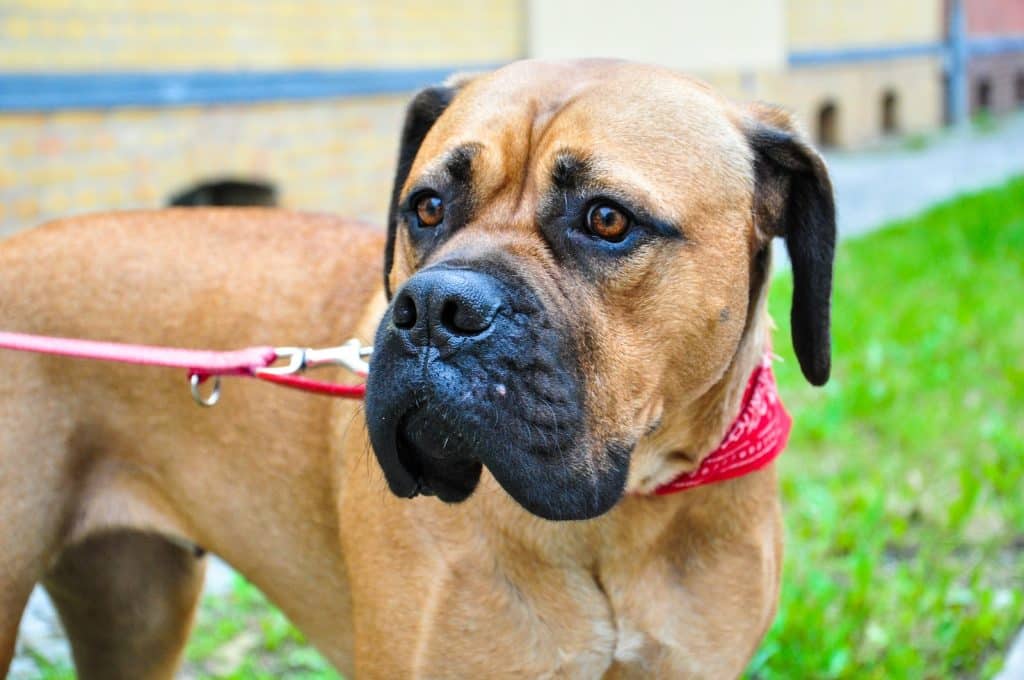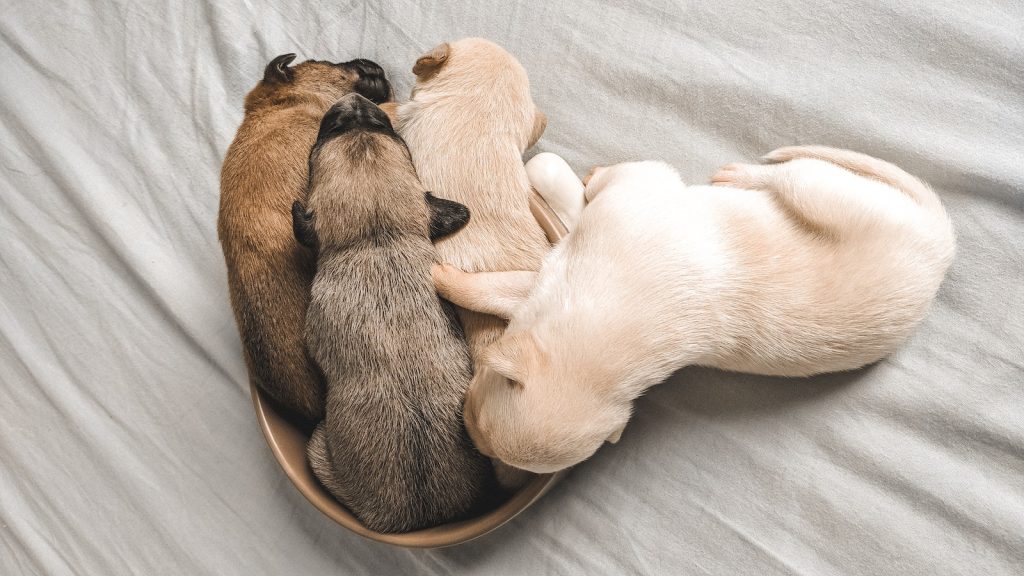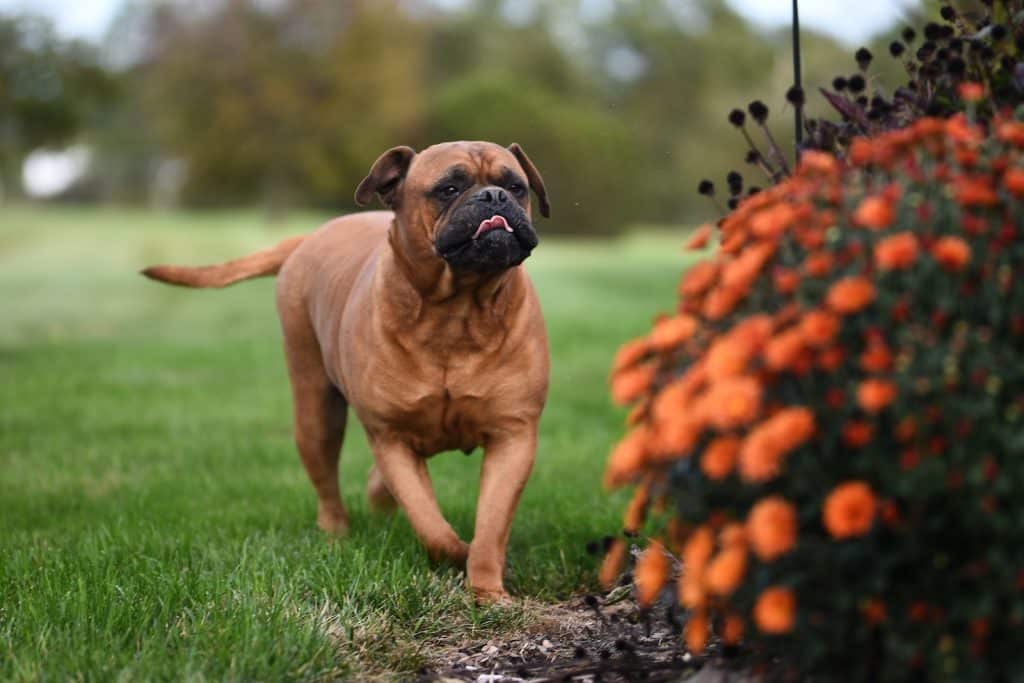
A Bullmastiff is easily recognized by its squared-off jaw and wide, wrinkled face. The black nose, hazel eyes, and large, powerful body of the Bullmastiff stand out against its red fur. Although they may appear intimidating, Bullmastiffs are gentle giants who love their families.
Breed Overview
Colors:
Red, brindle, and fawn
Compatible with:
Families seeking a companion and guardian for high-energy sports.
Temperament:
Loyal, brave, and easy-going
The Mastiff is a larger, more muscular cousin of the Bullmastiff. They were originally guard dogs at the country estates of English aristocracy and game preserves. You can be sure they will always keep an eye on you. Browse through the breed characteristics to see if a Bullmastiff would be a good match for your family.
Bullmastiff Characteristics
Energy:
Low-energy dogs need minimal physical activity, while high-energy dogs are in need of a lot of mental and physical stimulation. When choosing a puppy, it’s crucial to ensure that their energy level matches your lifestyle.
Trainability:
Dogs that are easy to train learn prompts and actions more quickly, with less training. Dogs who are more difficult to train require a little bit of patience and practice.
Health:
Some breeds of dogs are more susceptible to genetic problems than others. It doesn’t necessarily mean that all dogs will suffer from these problems, but some are more susceptible than others.
Lifespan:
Some breeds have a shorter lifespan than others due to their size, or genetic health problems. The lifespan of your dog is also affected by proper exercise, nutrition, and hygiene.
Sociability:
Some dog breeds have a more social disposition, towards both humans and dogs. Social dogs are more likely to approach strangers and ask for scratches and pets, while less-social dogs tend to be more reserved and cautious. It’s important that you socialize with your dog, regardless of the breed.
Bullmastiff Puppies

It is a myth that big dogs need the most exercise. It’s not necessary to run every day because of their size. A Bullmastiff can be relatively healthy if they do not lead a sedentary life. The Bullmastiff is a breed that benefits from a bit more exercise than the average dog. However, they are very adaptable and can be walked a few times a day.
The Bullmastiff is a dog with medium intelligence, which makes it easy to train. Socializing them as early as possible is important because they tend to be a little suspicious of people who are not in their immediate families. Bullmastiffs tend to be very friendly, and they don’t seem to have any issues with humans or other pets.
Bullmastiffs have a similar lifespan and health record to other large breeds. There are many genetic health issues that can cause Bullmastiffs to live only 9 years. Bullmastiffs are great companions and you will both quickly develop a bond if you can put aside the genetic health threats.
Temperament & Intelligence in the Bullmastiff

A Bullmastiff’s history makes him alert, loyal, and fearless. They are not likely to attack anyone, despite their history. They are also affectionate and loving to those that they know and care about. They are calm and tolerant in chaotic situations.
A bullmastiff needs a master with a strong leadership style and who will not be intimidated by the dog. Socializing them at an early age is important. They also benefit from being around other pets.
When training your Bullmastiff, be gentle and kind. Bullmastiffs can be stubborn, but they want to please their owners.
What breeds are good for families?
Bullmastiffs are calm dogs that make a great family pet if you don’t have young children or infants at home. They can easily knock over small children and, though they’re patient, there is no guarantee that they will not stand up to ill-mannered kids.

Can this breed get along with other pets?
Bullmastiffs generally get along with other animals. They get along with other animals, and they do better if they’ve been around them for most of their life. When interacting with other animals, male dogs are the biggest problem. They are dominant and could lead to future conflicts.
What to know before buying a Bullmastiff
The Bullmastiff is a large breed, and as such they require a number of specific needs to live a healthy life. You and your dog will be happier with a different pet if you’re not willing to meet these requirements.
Food & Diet Requirements
A large dog breed needs to grow slowly and steadily. Veterinarians generally recommend feeding your Bullmastiff food that is specifically designed for large breeds. Most large dogs can be fed two meals per day. Exercising immediately before or just after eating can cause bloating.
Exercise
Some Bullmastiffs enjoy more exercise than others. However, most of them get moderate amounts every day. You can keep your Bullmastiffs lean by taking them for a walk or playing fetch. While they may not be your running companion, they will certainly keep you company during lighter activities.
Training
Bullmastiffs have a strong, independent will. They require a master who is equally as determined. This breed is fairly easy to train as long as you’re persistent. The Bullmastiff has excelled at obedience, agility, and tracking. So the sooner you begin to train them, the better.
Grooming
Bullmastiffs shed, but this is more of a seasonal phenomenon than a permanent one. It is important to provide them with a healthy diet and an environment that is safe for their coat. Keep an eye out for any changes in their skin, such as if it becomes oily or drier. Report anything you find to your veterinarian. These dogs are relatively easy to maintain. You can keep them clean and happy by giving them a thorough, occasional bath.
Health Conditions
The health problems of bullmastiffs are more severe than those of other breeds. You may need to be aware of some health issues that come with their large size.
Minor Conditions
- Hip dysplasia
- Elbow dysplasia
- Skin disorders
- Panosteitis
Male vs female
Bullmastiffs are similar in size and temperament. Females tend to be smaller and cheaper than males. The males prefer to defend their territory while the females will protect the entire family. The males tend to be more submissive and less aggressive. Both dogs are stubborn but they will both love you. Both are wonderful family dogs that you will fall in love with easily.
Three little-known facts about the Bullmastiff
You shouldn’t judge a breed of dog by its appearance. Bullmastiffs have a rich history that you might not know. Some may even convince you to buy one.
1. They are bred to guard.
In 1860s England, the Bullmastiff was born. The Mastiff and Bulldog were crossed to create a pet capable of protecting their land against poachers. The Bullmastiff was a combination of these two breeds, which gave it the perfect balance between speed, strength and aggression for protecting their family and game.
2. They don’t even bark when they are on alert.
Guard dogs do not always bark at the slightest noise. Bullmastiffs are trained to track down and pin an intruder to the ground. Once they had the humans pinned, they were not aggressive. They were instead used to scare people away. Their role has changed over time to become a family pet, but it won’t take away from his origins and what he is bred for.
3. In the 1920s, Bullmastiffs were first seen in America.
It wasn’t until 1960 that the Bullmastiff was brought to the United States of America. John D. Rockefeller brought this breed over to the U.S. as a guard dog for his Tarrytown home, in New York. This breed gained in popularity after appearing in movies such as “Rocky”, and being owned by celebrities including Bob Dylan, Christina Aguilera, and Jon Bon Jovi.
Final Thoughts
Health issues and lifespan are the most important factors to consider when buying a Bullmastiff. Many people do not regret buying this breed of dog despite the risks. They are large and lovable family members that fit in with most people. You can rest easy knowing that these dogs will always be there for you.
Bullmastiffs are a breed that lives for only 9 years on average, but they can make those years some of the most memorable of your life. You’ll love their gentle personalities and fun personalities. They’ll make you laugh and give you some great memories.
Bullmastiffs may be aggressive.
Bullmastiffs are typically gentle and docile, but when aroused, they can become violent toward other male dogs and strangers. Despite this, the breed is exceptionally gentle with tiny children and pets. Despite their kind nature, they might be wary of strangers yet devoted to their owner.
What is the Bullmastiff’s weakness?
Weaknesses A fairy. A bug. Fighting.
How devoted are Bullmastiffs?
It is a devoted and protective companion. Gentle and generally nice with children, but can be too protective of them when they are in the presence of outsiders. Dogs and children, like any large dogs, should always be monitored. Devoted.
How powerful is a Bullmastiff’s bite?
552 PSI Because the Mastiff has a biting force of 552 PSI, it’s crucial not to aggravate the dog or keep it around strangers until it’s thoroughly trained.
Is it simple to train a Bullmastiff?
Bullmastiffs are quite simple to train. Given the breed’s power and independence, early socialization and training are critical. Bullmastiffs are natural protectors of their owners and property. There is no need for guard training; if its family is attacked, a Bullmastiff will respond correctly.
Bullmastiffs can bite?
Bullmastiffs are among the largest and strongest domesticated dogs, having enormous jaws and one of the greatest bite forces per square inch. As a result, a bull mastiff bite is likely to result in fractures, torn ligaments, tendons, and muscles, as well as hemorrhages.
Do Bullmastiffs guard their owners?
If you’re seeking for a faithful friend, your Bullmastiff will be there for you. These strong dogs create strong relationships with their owners and are fiercely protective of their families. These dogs will defend and serve everyone in their vicinity, whether they are adults or children.
Which dog has the most powerful bite?
The Kangal The Kangal is a big, powerful dog weighing between 100 and 130 pounds. They’ve been trained to protect sheep and other flocks from large predators like wolves, jackals, and bears. The Kangal has a powerful biting force of 743 PSI. It has the most powerful biting force of any dog breed.
Do Bullmastiffs enjoy going on walks?
Because they were raised to be guard dogs, they are quite content to lie around the house for lengthy periods of the day. When it comes to walks, your Bullmastiff may be hesitant – many would rather snooze on the sofa! And because of their size, they can’t be moved if they don’t want to go on a stroll.
Is the Bullmastiff a sociable breed?
When it comes to family relations, Bullmastiffs are kind and loving. Their typically calm, easygoing personalities make them ideal for families with well-behaved youngsters. When a stranger enters the scene, the bullmastiff’s laid-back attitude towards family members is likely to alter.